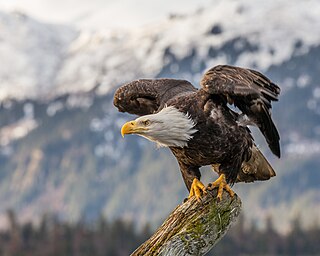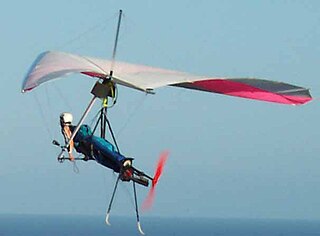
Parahawking is an activity that combines paragliding with falconry. Birds of prey are trained to fly with paragliders, guiding them to thermals.

Parahawking is an activity that combines paragliding with falconry. Birds of prey are trained to fly with paragliders, guiding them to thermals.
The roots of parahawking can be traced to aviators of the late 20th century such as naturalist Bill Lishman who in 1988 became the first person to lead the flight of geese with a light aircraft, and inspired the 1996 Columbia Pictures film Fly Away Home. [1]
In 2002 Italian aviator Angelo d'Arrigo crossed the Sahara and the Mediterranean Sea accompanied by an eagle, in an attempt to learn from them their techniques for migratory flight, by taking advantage of thermal air currents for long distance flight with low energy consumption. [2]
The term 'parahawking' was coined by British falconer Scott Mason, [3] who documented his endeavours in a film entitled Parahawking. Parahawking won the 'Air' category at the 5th Hory a Mesto International Festival of Mountain Films in Slovakia. [4]
Other noted parahawkers include Danish, two-time paragliding world champion, Louise Crandall, [5] whose film Flying with Eagles won first prize at the 2007 Coupe Icare film festival in St Hilaire, France. [6]
In 2010 the Nepalese government announced that Scott Mason's Himalayan Raptor Rescue Centre in Pokhara was to be closed following allegations that it was illegally holding endangered birds and that its practice of parahawking amounted to cruelty. [7] [8] Despite these allegations, Mason continued to practice parahawking in Nepal until at least 2017, when the Nepalese government confiscated a number of endangered birds of prey. [9]

The bald eagle is a bird of prey found in North America. A sea eagle, it has two known subspecies and forms a species pair with the white-tailed eagle, which occupies the same niche as the bald eagle in the Palearctic. Its range includes most of Canada and Alaska, all of the contiguous United States, and northern Mexico. It is found near large bodies of open water with an abundant food supply and old-growth trees for nesting.

A vulture is a bird of prey that scavenges on carrion. There are 23 extant species of vulture. Old World vultures include 16 living species native to Europe, Africa, and Asia; New World vultures are restricted to North and South America and consist of seven identified species, all belonging to the Cathartidae family. A particular characteristic of many vultures is a bald, unfeathered head. This bare skin is thought to keep the head clean when feeding, and also plays an important role in thermoregulation.

Hawks are birds of prey of the family Accipitridae. They are very widely distributed and are found on all continents except Antarctica.

The Accipitridae is one of the three families within the order Accipitriformes, and is a family of small to large birds of prey with strongly hooked bills and variable morphology based on diet. They feed on a range of prey items from insects to medium-sized mammals, with a number feeding on carrion and a few feeding on fruit. The Accipitridae have a cosmopolitan distribution, being found on all the world's continents and a number of oceanic island groups. Some species are migratory. The family contains 256 species which are divided into 12 subfamilies and 75 genera.

Falconry is the hunting of wild animals in their natural state and habitat by means of a trained bird of prey. Small animals are hunted; squirrels and rabbits often fall prey to these birds. Two traditional terms are used to describe a person involved in falconry: a "falconer" flies a falcon; an "austringer" keeps Goshawks and uses accipiters for hunting. In modern falconry, the red-tailed hawk, Harris's hawk, and the peregrine falcon are some of the more commonly used birds of prey. The practice of hunting with a conditioned falconry bird is also called "hawking" or "gamehawking", although the words hawking and hawker have become used so much to refer to petty traveling traders, that the terms "falconer" and "falconry" now apply to most use of trained birds of prey to catch game. However, many contemporary practitioners still use these words in their original meaning.

The bearded vulture, also known as the lammergeier and ossifrage, is a very large bird of prey in the monotypic genus Gypaetus. Traditionally considered an Old World vulture, it actually forms a separate minor lineage of Accipitridae together with the Egyptian vulture, its closest living relative. It is not much more closely related to the Old World vultures proper than to, for example, hawks, and differs from the former by its feathered neck. Although dissimilar, the Egyptian and bearded vulture each have a lozenge-shaped tail—unusual among birds of prey. It is vernacularly known as Homa, a bird in Iranian mythology.
In psychology and ethology, imprinting is any kind of phase-sensitive learning that is rapid and apparently independent of the consequences of behaviour. It was first used to describe situations in which an animal or person learns the characteristics of some stimulus, which is therefore said to be "imprinted" onto the subject. Imprinting is hypothesized to have a critical period.

The cinereous vulture is a large raptor in the family Accipitridae and distributed through much of temperate Eurasia. It is also known as the black vulture, monk vulture and Eurasian black vulture. With a body length of 1.2 m, 3.1 m (10 ft) across the wings and a maximum weight of 14 kg (31 lb), it is the largest Old World vulture and largest member of the Accipitridae family.

The ferruginous hawk is a large bird of prey and belongs to the broad-winged buteo hawks. An old colloquial name is ferrugineous rough-leg, due to its similarity to the closely related rough-legged hawk.
Angelo d'Arrigo was an Italian aviator who held a number of world records in the field of flight, principally with microlights and hang gliders, with and without motors. He has been referred to as the "Human Condor".
Coupe Icare, also known as the Icarus Cup, is an annual festival of free flight held between Saint-Hilaire and Lumbin. The festival typically lasts four days and is held in the early autumn. Coupe Icare is best known for its Concours de déguisements, in which paraglider and hang glider pilots fly in costume to compete for prizes.
Raptor rehabilitation is a field of veterinary medicine dealing with care for sick or injured birds of prey, with the goal of returning them to the wild. Since raptors are highly specialized predatory birds, special skills, facilities, equipment, veterinary practices and husbandry methods are necessary.
Training raptors is a complex undertaking. Books containing advice by experienced falconers are still rudimentary at best. Many important details vary between individual raptors, species of raptors and between places and times. The keeping and training of any raptor is strictly and tightly regulated by U.S. state and federal laws. Anyone in the USA who is interested in flying raptors must seek out a state and federally licensed falconer to sponsor them through an apprenticeship period lasting two years at a minimum, and often considerably longer.

A foot-launched powered hang glider (FLPHG), also called powered harness, nanolight, or hangmotor, is a powered hang glider harness with a motor and propeller often in pusher configuration, although some can be found in tractor configuration. An ordinary hang glider is used for its wing and control frame, and the pilot can foot-launch from a hill or from flat ground, needing a length of about a football field to get airborne, or much less if there is an oncoming breeze and no obstacles.
The Peregrine Fund is a non-profit organization founded in 1970 that conserves threatened and endangered birds of prey worldwide. The successful recovery of the peregrine falcon in the United States, which was removed from the U.S. Endangered Species List in 1999, enabled the organization to expand its mission to include other endangered raptors around the world. The Peregrine Fund is headquartered at its World Center for Birds of Prey in Boise, Idaho, on a 580-acre (2.3 km2) campus with breeding and research facilities, an administrative office, interpretive center, research library, and archives.

Sous Lieutenant Eugène Gilbert was a World War I flying ace credited with five aerial victories. He had also been a famous pioneer pre-war racing pilot, flying in many countries throughout Europe.

Phillip Edward Brougham Glasier was Britain's leading expert on hawking and falconry. Glasier initiated a new interest in falconry in both the UK and the United States of America. He spent much of his life involved with the conservation and breeding of raptors and bringing them to public attention through the foundation of the Falconry Centre, Newent, Gloucestershire, as well as through books, lectures and public demonstrations. He founded the Hawk Trust with John Burkett and the Raptor Breeders' Association.

In the United Kingdom, raptor persecution is a crime against wildlife. The offence includes poisoning, shooting, trapping, and nest destruction or disturbance of birds of prey.
Thomas de Dorlodot is a professional adventurer, paraglider pilot and public speaker. Born in Belgium, he is known for his exploratory journeys around the world, flying remote areas by paraglider and paramotor in places such as Pakistan, Madagascar and French Polynesia.